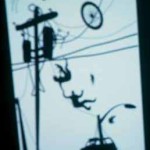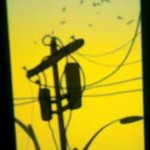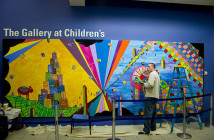Will we ever tire of 9/11 artwork? Probably not, just as long as the framers of popular debate continue to espouse viewpoints that only take into account the two most disparate philosophies they are able to conjure. 9/11 is easy pickings for rhetorical flourishes from both the ostensibly good and evil and artists alike; the subject is still freshly controversial enough to foist any ideology and make ones own for a variety of means. Paul Chan, in his installation 1st Light (2005) for the ICA’s Momentum series, attempts to envisage the relationship between an ideology and the society where it manifests; all from a critically distance viewpoint.
Chan claims that his art is non-political, reserving his frequent activism to non-artistic endeavors or collaborations, as he believes “political art” to be ineffective. His video Baghdad in No Particular Order (2004) doesn’t have a narrative and is devoid of the anti-war symbolism one would find in any contemporary ‘counter-culture’ documentary even though it was shot in Baghdad in the winter of 2002/03 while Chan was traveling with the diplomatically unsanctioned group Voices in the Wilderness. Baghdad seemed just to be a tool to broaden the dialogue on Iraq before the war, to allow the US a glimpse into the relatively normal country many Americans wanted to bulldoze with smart bombs to make way for US oil interests.
In 1st Light Chan uses Plato’s allegory of the cave as the framework for his piece, transforming the Momentum gallery into a darkened cavern with a single video projection obliquely projected on the floor. Combined with Leave a Trace, leave a wound (After Henri Michaux) (2005) a thin trickle of light comes out of a slightly opened door covering the sole window of the gallery. The video projection resembles a light coming through a window, the figures in the work all silhouettes or blurred shadows cast down on the floor of the gallery. The piece is 14 minutes long, with an interval of shifting colors, which follow the times of day. The first image, or shadow, you see is that of a rising telephone pole, orienting us to the bottom and top of the video field. The pole stays static throughout the piece, its cross-like prominence ‘framing’ the video and seeming to suggest the very ideology framing our current national debate. Debris floats into space and humans fall through the air, their arms flitting like puppets, while birds disappear and reappear on a light pole as if the work is a shoddy stop-motion animation. It is an apocalyptic vision that we can all see in the replayed video of 9/11 and hear about in the speeches of our leaders.
One can allow them self to believe that this work is apolitical, attempting to only encourage a dialogue about current issues without commenting on them. However, the images are too significant to not bring about the same visceral response we get while watching 9/11 footage. It is like South Park or Team America in its apparent criticism, though less malicious. In some ways, the piece is like an animated Kara Walker, and though less specifically in the case of Chan, they each employ silhouettes to critique the public’s over-simplification of identity and political issues.
The work may have been better off as a film projection because the contrast distinction between pitch black and white is much greater in film than any video projector currently available, making the work more Walker-esque. However, the use of video comments on how we are enabled to perceive our world, as video is the medium of television. Taking the allegory of the cave another step: Imagine the video projection itself as a metaphor for mass media. The cross, the symbol of Christianity framing the debate, the debris and bodies become a shadow play of the ‘Rapture’ on the cave’s wall. We become the prisoners of Plato’s cave when we enter the installation. Religion frames the public debate in the post-9/11 world, yet Chan shows us that it’s a hokey debate and in vain as there is much more to see outside ‘the cave.’ The title 1st Light implies that the ‘light’ in the cave or glow of the television is not the truth, as we often assume.
Whether the installation itself is an encapsulated metaphor for our current state of affairs, or we are perhaps the freed and enlightened former prisoner returning to the cave to liberate its captives, is hard to say. However, as Chan purports to be a non-political artist, he seemingly asks us to figure that out for ourselves, and indeed, believing that we are the enlightened one will only place us in a diametrically opposing and irreconcilable position to the other prisoners. Furthermore, the ‘intellectual illumination’ achieved by emancipating oneself from Plato’s cave, the coming to know about the sun, is in the allegory only interpreted as becoming aware of ‘God,’ the root of this debate. The allegory continues on, revealing that our return to the cave will only lead to our own demise. As the cave’s prisoners, unaware of any state of bondage, it will resolutely refuse our attempts to edify them, and aptly do away with us.
Links:
Institute of Contemporary Art
"Momentum 5: Paul Chan" is on view from September 21, 2005 - January 16, 2006 at the Institue of Contemporary Art, Boston.
All images are courtesy of the artist and the ICA Boston






